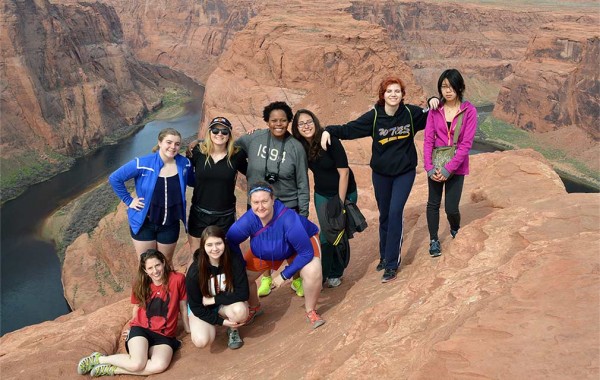
Kelda Olson Hutson ’02 MAT ’03 (front, far right) took her daughter (on her right) and other high schoolers hiking. They’re pictured above the Colorado River in Arizona.
Kelda Olson Hutson ’02
If you’d told Kelda Olson Hutson ’02, MAT’03 when she first arrived at Colgate that she’d someday make important contributions to the field of evolutionary biology, she would not have believed you. At that time, Hutson didn’t even believe in evolution. “I was raised with fundamental Christian beliefs,” she explained. “My time at Colgate pushed me to think in other ways.”
When she took a core class in Western traditions, it was the first time Hutson was asked to approach the Bible with the same critical tools she’d bring to any other book. “That, coupled with the evidence that my professors gave for radiometric dating and the geological span of time, [made] it all start clicking,” said Hutson, a geology major who chose Colgate specifically for that program.
“My professors were very respectful of where I was coming from, but they stretched and pushed and pulled me, allowing me to be receptive to other ideas and to being a scientist,” she remembered.
That, coupled with the evidence that my professors gave for radiometric dating and the geological span of time, [made] it all start clicking.
Still, the implications of accepting the theory of evolution continued to unnerve her. She didn’t fully put aside her creationist beliefs until she met her husband, Joel, then a graduate student in biology. “He was the first person to explain evolution to me in a way that did not totally clash with what I had been raised to think,” Hutson said. “He broke it down and answered my questions carefully and patiently until I was able to see evolution for what it is instead of the misconceptions I’d held onto for so long.”
Soon after they married, Joel needed help with his graduate studies research for a presentation before the Society of Vertebrate Paleontologists. It was slimy work, testing the range of motion of severed alligator arms — first intact, then without scales, then without muscles and tendons, then without ligaments, and finally as bare bones — and comparing them to published alligator behaviors. The comparison, they believed, would be instructive to paleontologists who make inferences based on the range of motion of fossilized dinosaur bones. Hutson donned a garbage bag (paleontologists rarely use lab coats) and got her hands dirty. The result was a convincing presentation that affirmed decades of research in dinosaur paleontology.
“The big picture is that we are helping paleontologists have more confidence when stating that dinosaurs could move their forelimbs to a certain degree, which helps in describing their behaviors and movements for hardcore scientific analyses, but also popular depictions of dinosaurs, such as with museum mounts and even movies like Jurassic World,” Hutson said.
She is now a high-school science teacher in Gurnee, Ill., and her husband is an adjunct professor at several Chicago-area colleges. They continue to work together; they’ve published as a pair five times in the last four years, including in major journals like the Journal of Zoology and Geodiversitas. In June, they were interviewed together for a story in Scientific American. Most recently, their research has explored the question of whether dinosaurs such as velociraptors evolved from four-legged creatures or from two-legged flying ancestors.
“There’s tremendous satisfaction in putting our work out there as part of the public record,” said Hutson. “For me, it changes the way my students look at me. It changes the way that they listen to me.”
These days, many of Hutson’s students come from creationist and fundamentalist Christian backgrounds much like her own. Rather than force them to accept the theory of evolution against the wishes of their parents and pastors, Hutson aims to exercise the same patience and care that she received from her Colgate professors.
“I come from both worlds,” she said. “I have a gentle approach.”
— Mike Agresta






